Currently, two archaeological treasures are being unearthed in Jerusalem. One is the Pool of Siloam at the southern end of the City of David, and the other is the excavation and restoration of the Pilgrimage Road connecting the Pool of Siloam with the Temple Mount. There are a number of references to pools in both the Old and New Testaments. In 2 Kings 20:20, we read, “. . . he [Hezekiah] made the pool and the tunnel by which he brought water into the city [of Jerusalem] . . .” (NIV). This is the famous “Hezekiah’s Tunnel,” also referred to in 2 Chronicles 32:30: “It was Hezekiah who blocked the upper outlet of the Gihon Spring and channeled the water down to the west side of the city of David . . .” (NIV). The route of Hezekiah’s Tunnel is well known. It starts at the Gihon Spring and follows a winding route 1,750 feet southward, ending at a small reservoir. Traditionally, this reservoir has been related to the “waters of Shiloah” (Is 8:6), the “Pool of Shelah” (Neh 3:15), and the “pool of Siloam” (Jn 9:1–11). Excavations in the late 19th century, however, determined that the reservoir was constructed in the fifth century AD in conjunction with the Church of Siloam, built to commemorate Jesus’s miracle of healing the blind man. Nothing earlier than the church was found. (Ronny Reich and Eli Shukron, “The Pool of Siloam in Jerusalem of the Late Second Temple Period and Its Surroundings,” in Unearthing Jerusalem: 150 Years of Archaeological Research in the Holy City, ed. Katharina Galor and Gideon Avni [Winona Lake, IN: Eisenbrauns, 2011], 241–55.)
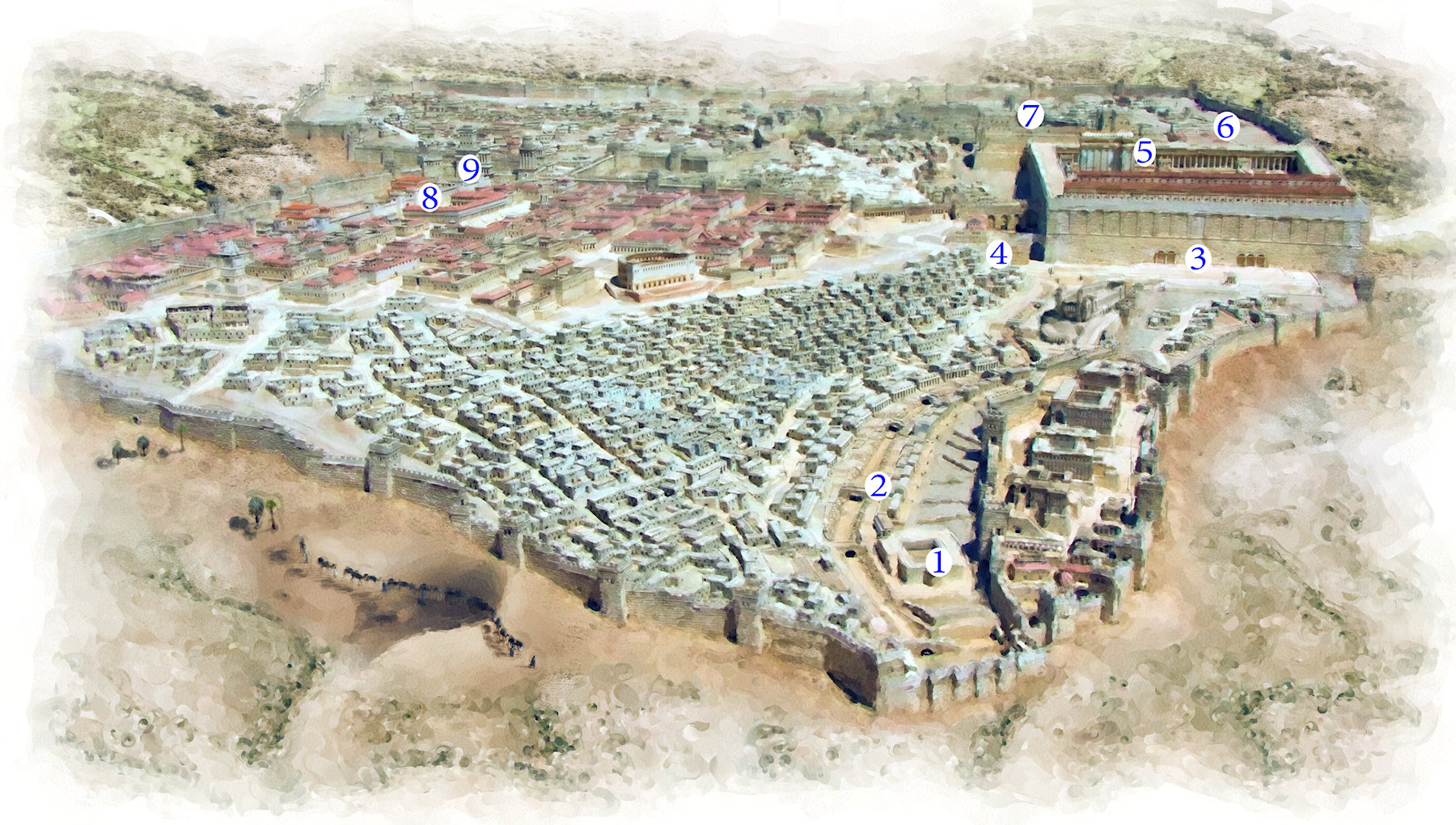
1) The Siloam pool and reservoir are fed by the underground Gihon springs.
2) The stepped street to the Temple complex.
3) The Huldah Gates (Triple and Double Gates) on the Southern Wall of the Temple complex were originally built during Herod’s expansion of the Temple. They have been blocked since the Middle Ages. Excavations in what is part of the Ophel have revealed cisterns and ritual baths for visitors to the Temple below a monumental staircase leading up to the gates.
4) Robinson’s Arch, which was part of a massive two-way (or possibly four-way) stairway with bridges, arches, and landing features that were architecturally unique for the time period.
5) The Temple complex was lavishly expanded upon by King Herod.
6) Pools of Bethesda.
7) The Antonia Fortress.
8) Herod’s palace.
9) The Governor’s palace, or Praetorium.

A portion of Hezekiah’s Tunnel. Credit: Todd Bolen / BiblePlaces.com.
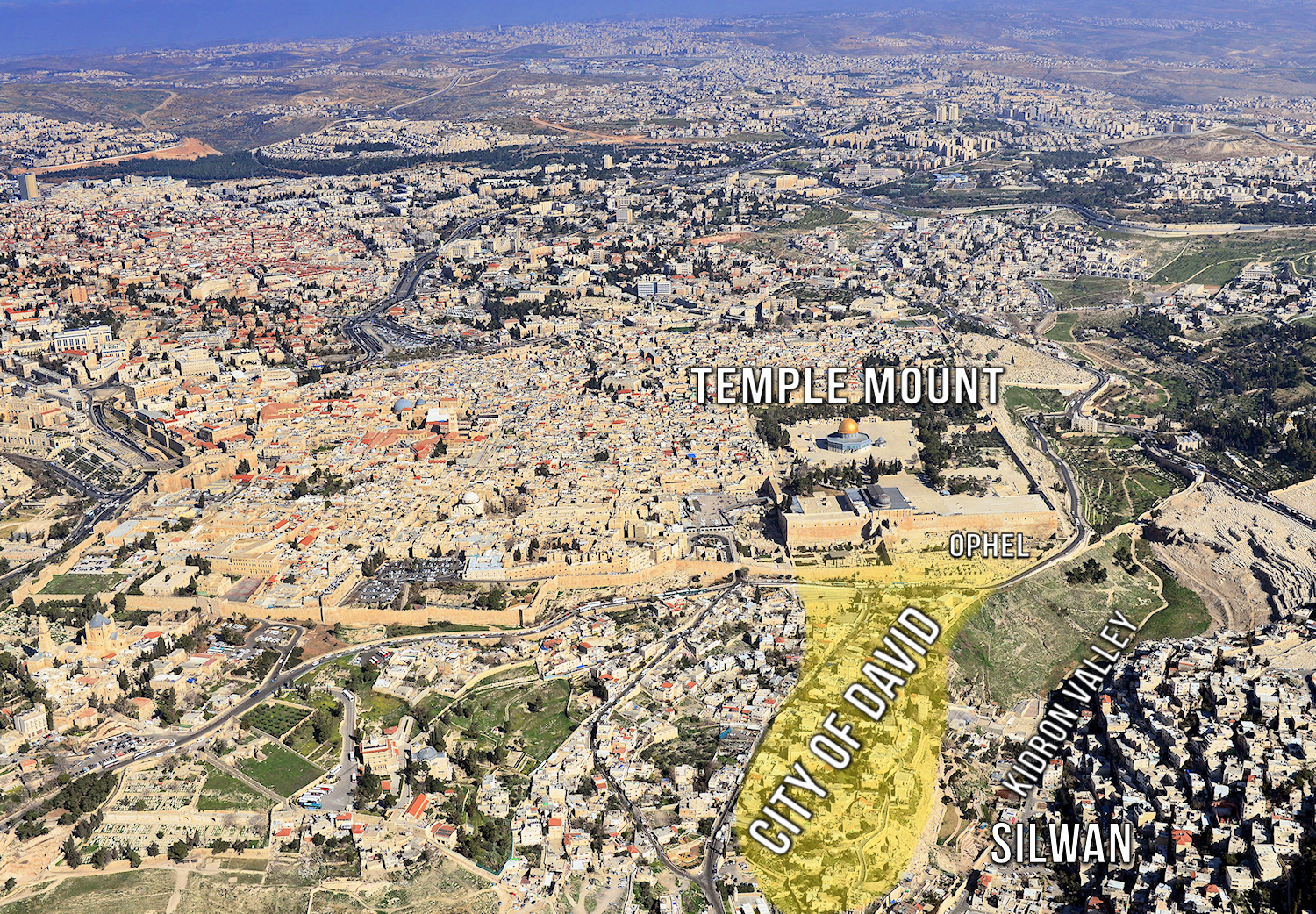
The City of David (shaded). The Ophel (meaning a hill or raised area) overlooked the city. Jerusalem was known as Jebus and was occupied by a Canaanite tribe known as the Jebusites when the Israelites came into Canaan under Joshua. Jebus was defeated in spite of tribes from Hebron, Eglon, and Lachish banding together against the Israelites (Jos 10). However, Joshua’s army was unable, or unwilling, to completely drive out the Jebusites. Thus, they dwelt with the people of Judah in Jerusalem until David rose to power and finally expelled them ca. 1004 BC (2 Sm 5:6–10; 1 Chr 11:4–9; 1 Kgs 9:15).
It has been known for some time that about 70 yards southeast of the reservoir is a larger, dried-up pool called Birket el-Hamra (“red pool”) (Elaine A. Phillips, “The Pools of Siloam: Biblical and Post-biblical Traces,” Tyndale Bulletin 70, no. 1 [2019]: 41–54.) In June 2004, when a new sewer line was being installed in the area of Birket el-Hamra, workers came upon a number of stone steps. After digging through 13 to 16 feet of mud and silt, archaeologists determined that the steps were part of a monumental, stepped, trapezoidal pool some 180 × 164 feet in size. It was fed by a channel that ran from the small reservoir to the pool. The pool was in use in the first century, up until the destruction of Jerusalem in AD 70, and is clearly the Pool of Siloam mentioned in the account of the healing of the blind man in John 9:1–11.
An esplanade, or walkway, was found on the north side of the pool, paved with well-cut and precisely dressed limestone slabs. The quality of stonework resembled that of the first-century paved street along the Western Wall of the Temple Mount. This esplanade was the beginning of the Pilgrimage Road, a stepped street that led from the Pool of Siloam to the Temple. Pilgrims would cleanse themselves in the pool, then walk up the Pilgrimage Road to the Temple to offer sacrifices. During the Feast of Tabernacles, pilgrims would fill a golden vessel with water “from the Shiloaḥ” (Mishnah Sukkot 4:9) and carry it up to the Temple for a libation offering. It is likely that they sang the Psalms of Ascent (Psalms 120–134) as they made their way up to the Temple.

Excavation and restoration of the Pilgrimage Road, or Stepped Street, reveals a small platform set up along the way from the Pool of Siloam to the Temple complex. Credit: City of David Archaeological Site, https://cityofdavid.org.il/.
A small probe was made outside of and below the southwest corner of the pool. Here a massive wall dating to the Iron Age was revealed—the southern fortification wall of the city—as well as several steps. Could these steps be part of Hezekiah’s pool? Only time will tell. It is estimated that it will be another five years before excavations at the Pool of Siloam will be completed and the site opened to visitors.

Artist’s rendering of the newly excavated Pool of Siloam at the southern end of the City of David, 76 yards southeast of the traditional Pool of Siloam. The beginning of the stepped Pilgrimage Road can be seen in the upper right corner. (Shalom Kveller, City of David Archives)
The second archaeological treasure currently being unearthed is the Pilgrimage Road. Constructed over a ten-year period, it was completed during the rule of Pontius Pilate, governor of Judea (AD 26–36). It lies beneath the village of Silwan, requiring archaeologists to conduct a massive tunneling operation to clear the street so it can be walked on anew, albeit underground. Work has been going on for about a decade and is hoped to be finished in another two years. The Pilgrimage Road was the main thoroughfare connecting the northern and southern sectors of Jerusalem. It is 26 feet wide and some 650 yards long, with the remains of ancient shops on either side, and ends at the Western Wall.
We do not know exactly where Jesus healed the blind man. But He previously had left the Temple grounds (Jn 8:59), and then He saw the blind man “as he went along” (Jn 9:1; NIV). After placing mud on the man’s eyes, Jesus said, “‘Go,’ . . . ‘wash in the Pool of Siloam.’ . . . So the man went and washed, and came home seeing” (Jn 9:7; NIV). Undoubtedly, the blind man used the Pilgrimage Road while going to and from the Pool of Siloam. (See City of David, “Uncovering the Pilgrimage Road to Jerusalem - Revealing the Sacred Ancient Journey,” September 30, 2021, video, 5:15, https://www.youtube.com/watch?v=XTkCrQHBF0o.)
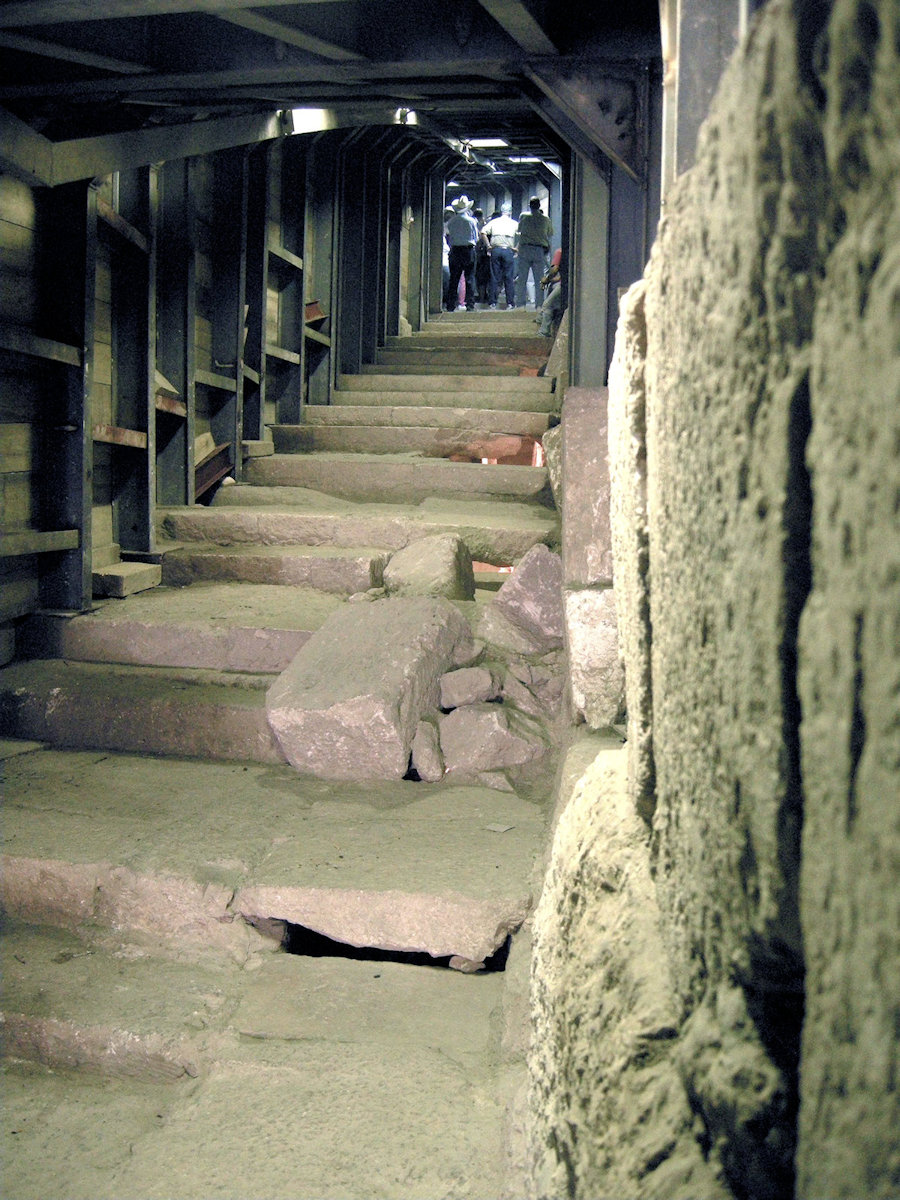
Steps along the excavated pilgrimage walkway. Credit: Steve Rudd.
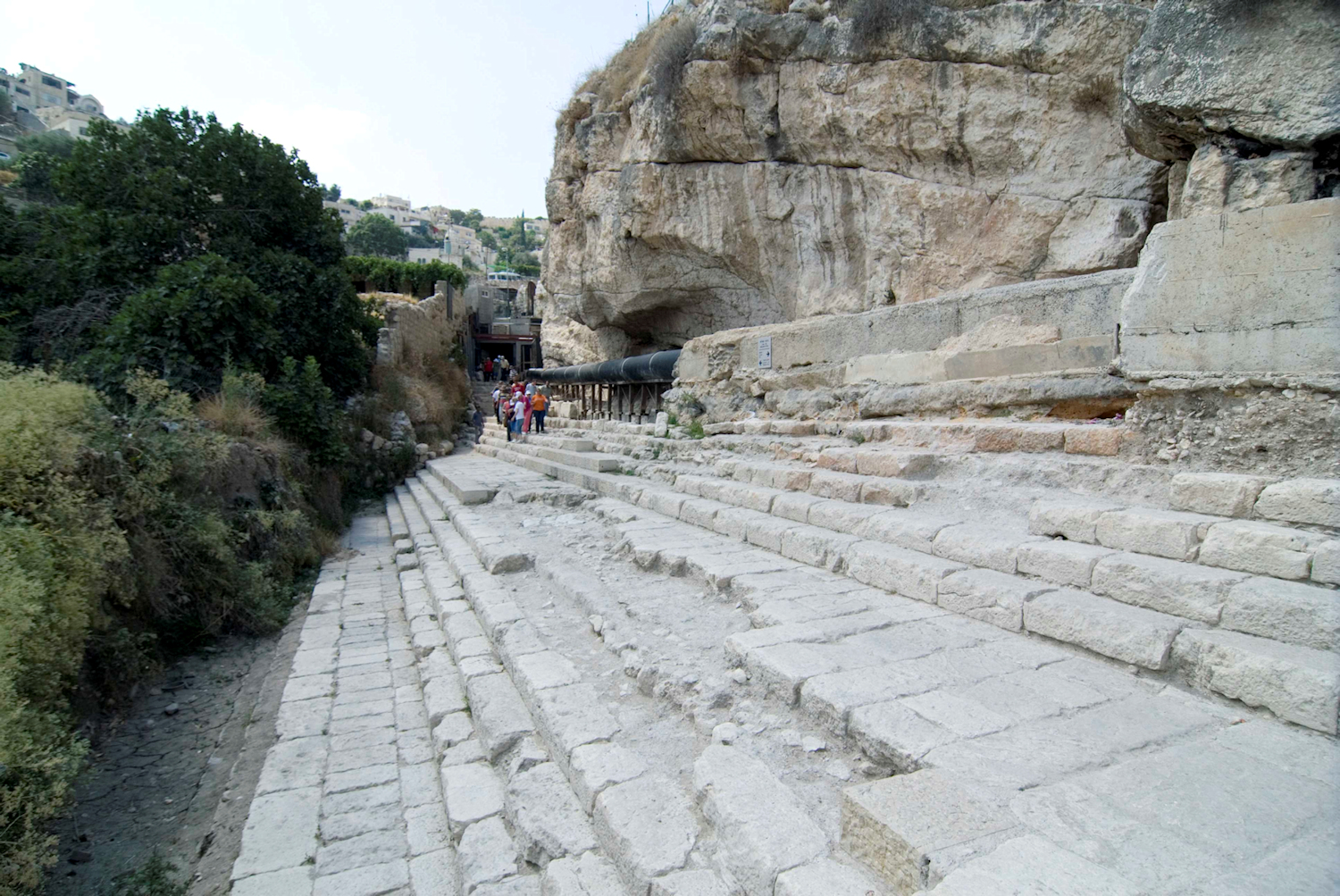
Excavations between 2004 and 2007 revealed steps leading into a large (approximately three-quarters of an acre) rock-cut pool. Credit: Steve Rudd.
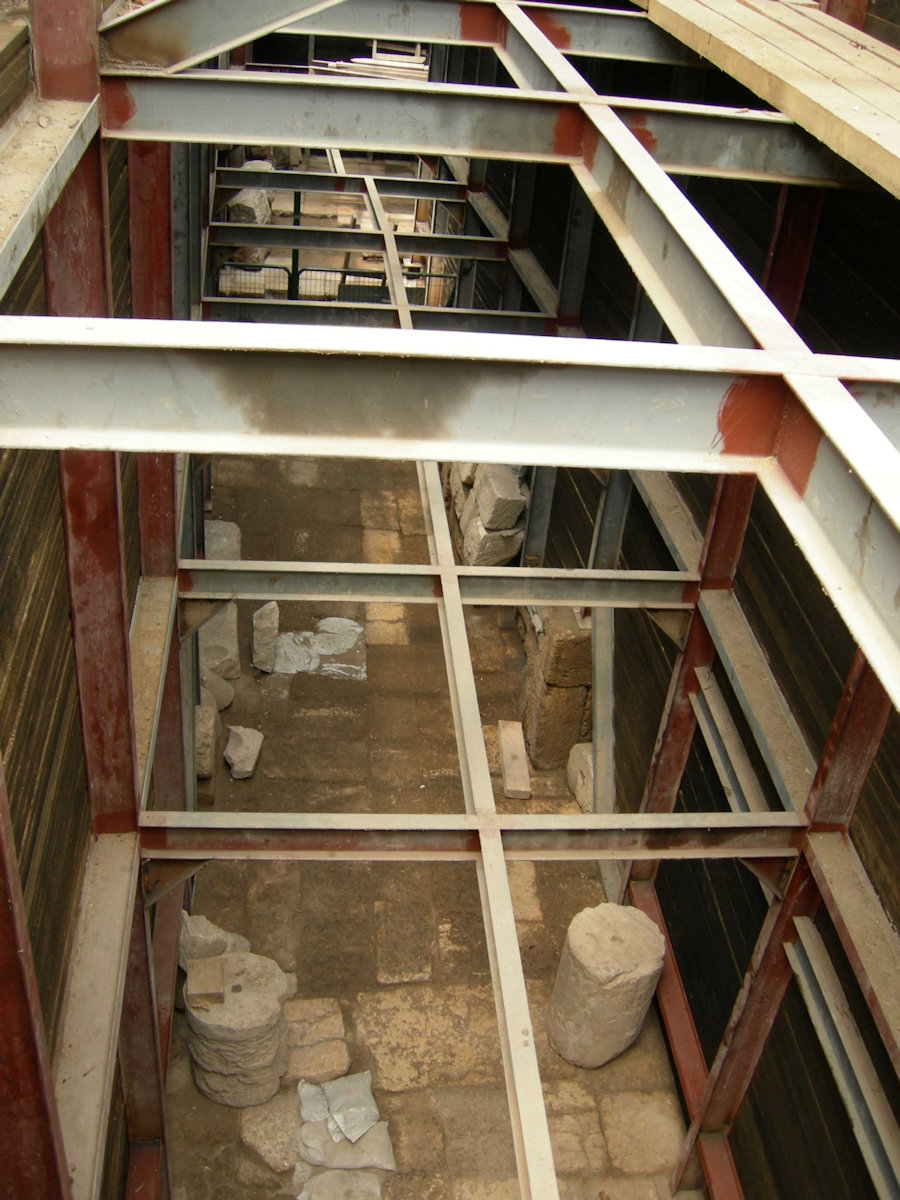
Adjacent to the pool was a paved plaza that may have been either a columned portico or an enclosed promenade for visitors to the pool. Credit: Steve Rudd.
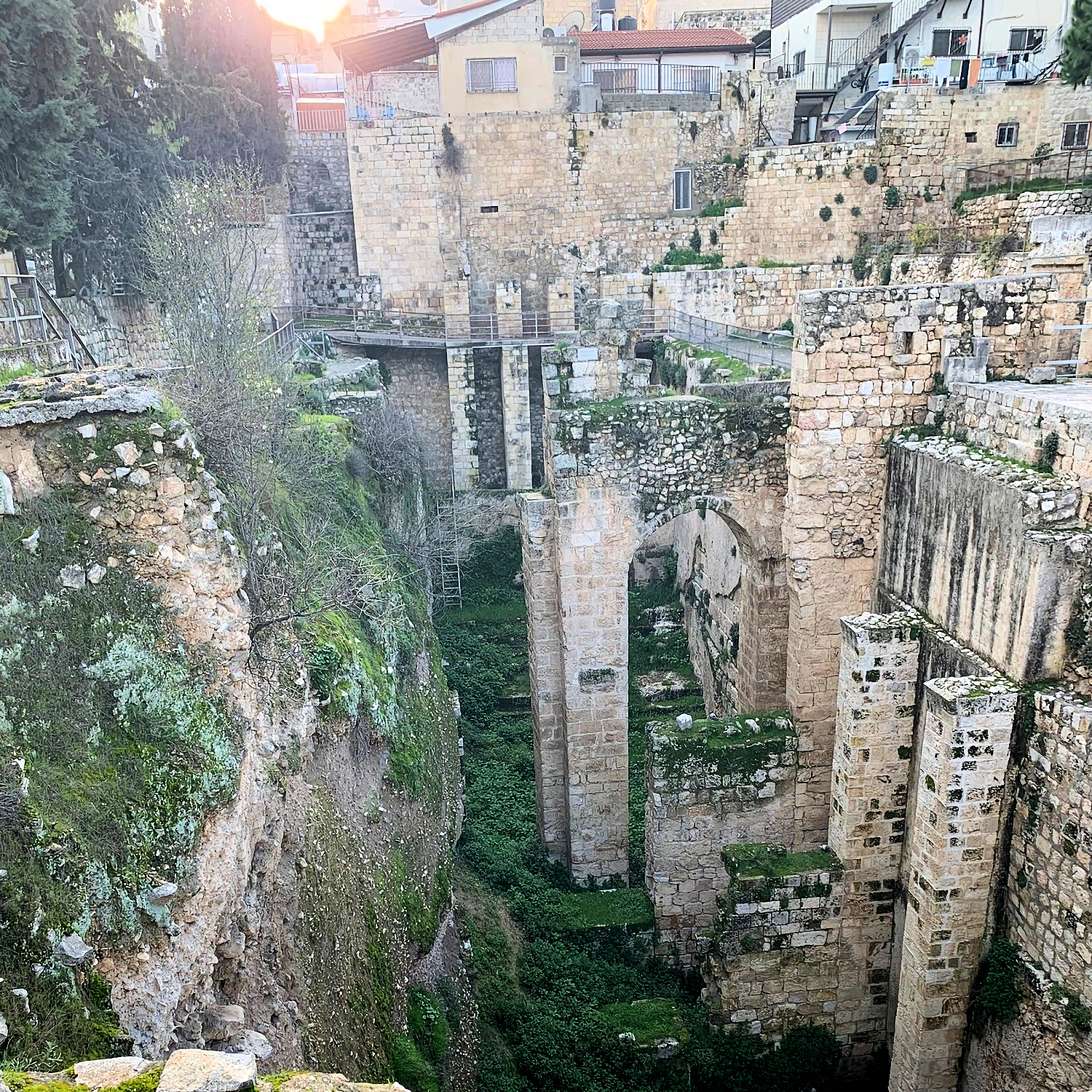
The ruins of the Pools of Bethesda are complicated. Since the destruction of Jerusalem in AD 70, a Roman healing temple, a Byzantine basilica, a Crusader chapel, and an Ottoman-era structure were all built, and were destroyed or came to ruin, over and around the pools. In the 1900s, archaeologists uncovered the two large reservoirs, separated by a rock-wall dam, with five porticos, or colonnades, matching the description in John’s Gospel (Jn 5:2). Credit: Public Domain.
When both projects are completed, it will be a thrilling experience to visit the pool that Jesus used to heal a man blind from birth, and walk the road that the blind man, and perhaps Jesus, Paul, the apostles, and other early Christians, walked. If you are able to go, be sure to take your Bible with you so you can read the Psalms of Ascent as you walk and feel what the Jewish and early Christian pilgrims felt as they went up to the Temple.
I rejoiced with those who said to me,
“Let us go to the house of the Lord.”
Our feet are standing
in your gates, Jerusalem. . . .
Pray for the peace of Jerusalem:
“. . . May there be peace within your walls. . . .”
. . . “Peace be within you.” (Ps 122: 1–2, 6a, 7a, 8b; NIV)
Bibliography
City of David. 2021. “Uncovering the Pilgrimage Road to Jerusalem - Revealing the Sacred Ancient Journey.” September 30. Video, 5:15. https://www.youtube.com/watch?v=XTkCrQHBF0o.
Phillips, Elaine A. 2019. “The Pools of Siloam: Biblical and Post-biblical Traces.” Tyndale Bulletin 70, no. 1: 41–54.
Reich, Ronny, and Shukron, Eli. 2011. “The Pool of Siloam in Jerusalem of the Late Second Temple Period and Its Surroundings.” Pp. 241–55 in Unearthing Jerusalem: 150 Years of Archaeological Research in the Holy City, ed. Katharina Galor and Gideon Avni. Winona Lake, IN: Eisenbrauns.











